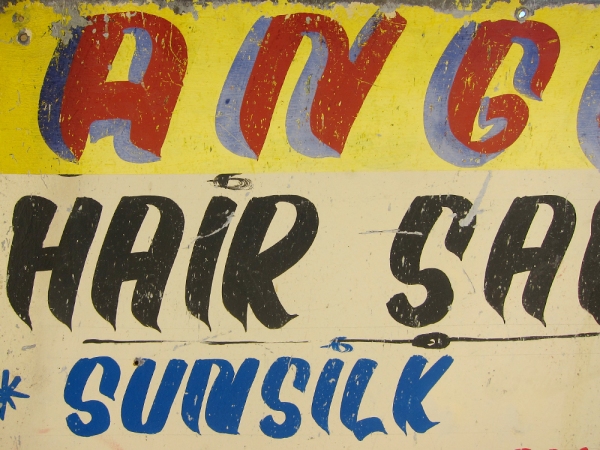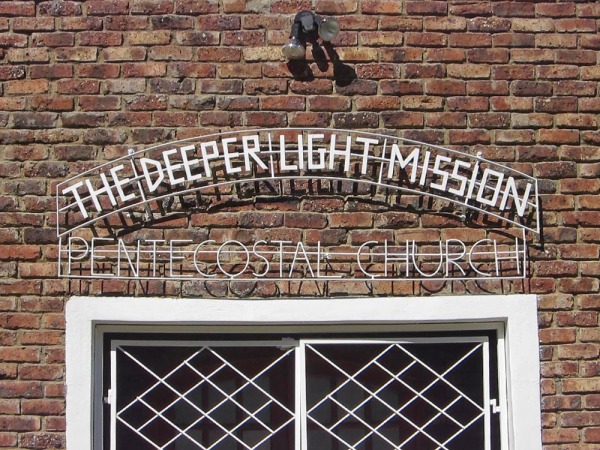Victor the signwriter.
I first spotted Victor Gardener’s work in 2005 while visiting Adelaide in the Eastern Cape, South Africa. It was everywhere to be seen around the small town, as well as the neighbouring towns of Bedford and Fort Beaufort. The letters have lots of personality and a unique appearance that set them apart from other local signwriting. I was immediately taken by the way the typography seem to “bulge” to the top left-hand side of each character as well as some of the unique embellishments like the quirkiness of the dots on the i’s. And, of course, the drop shadows.
After some research and a few phone calls I managed to track Victor down in the town of Somerset-East. And as I recently revisited Adelaide again, I didn’t hesitate to travel the 80 kilometers to meet the man.
We met mid-morning in the main road of Somerset East and over the next few hours I was given a tour via his extensive work throughout the little Karoo dorp. While we drove through the town and adjoining township he filled me in on his journey to becoming a signwriter.
Victor started out in 1980 as an apprentice at Haylock Signs in East London, and did extensive work both there and in the Transkei. He was schooled in the art of engraving trophies and rings, the silkscreening of posters and t-shirts (for which he also created the artwork) and signwriting.
He moved to Somerset-East in 1995 and has been working and living there ever since. His involvement in the community is not only visible through the work he has done (often pro-bono for local schools and churches), but also in how everyone recognized and heartily greeted him, as we went from site to site. Or perhaps this was because he had a curious mlungu with a camera in tow?
His signwriting comprises two fields – his natural “house style” which is clearly visible as his signature and “corporate work” which entails the painting of logos and slogans. For this specific work, Victor normally starts by measuring out newsprint to the size of the “canvas” he has to work with. He sticks this up to a wall in his studio (at the back of his house) and uses an overhead projector to get the artwork to the desired size. Instead of copying the artwork, he uses a tracing wheel to pierce holes through the paper. Once the newsprint goes up on site, he uses a chalk bag to dab the colored chalk through the holes the tracing wheel has left. Once he removes the newsprint, his outline is visible.
I had the pleasure of watching Victor employ his natural style – great to see the confidence and accuracy with which he lays down each stroke. I commissioned him to do some work based on some of my sketches and will reveal the result of our collaboration here in months to come.
In an age where everything revolves around digital and being instant, it’s refreshing to see someone who has mastered their craft, taking time and pride in using their hands. Also great to visit charming Somerset East, mostly known for it’s famous resident, artist Walter Battiss, who was born there in 1906. But if you ever get a chance to visit this quaint little town, don’t forget to look out for the work of Victor Gardener.










This is incredible Brandt
Amazing find – well done for following him up!
Thanks Mallix – was very happy to finally get hold of him. And what a lovely guy to boot.
Thats Genius!
What a talent.
Absolutely delighted to see what you posted about Victor. i am in the Tourism office in Somerset East, and you have introduced me to local treasure I was not aware of. Will definitely be looking Victor up, Thank you!
Brandksi, good boy. Nice find. We need keep an eye out for these guys as they are a dying breed. In Durban we cover the work of Slim, a ‘ticket writer’ working Overport in the new issue of ijusi #26. But Slim only works in plaka, unlike Victor who also works with metal – even better than his painted signs.
Brandt, this is orsum. And the way you’ve described his work and your fascination around it, is equally orsum. And for your next trick, a book?
Lovely post on an idiosyncratic craft.
I was particularly take with the description of Victor’s use of newsprint and chalk bag – formally known as a “cartoon”. This method was readily employed by the Renaissance masters: http://en.wikipedia.org/wiki/Cartoon#Fine_art
Sjoe Brandt, het nooit geweet jy skryf so goed nie!! Wat ‘n interessante artikel…
Thanks for all the comments:
Ros: Glad to hear.
Garth: Agreed about the dying breed. And I have many other examples of Victor’s metal work – wonderful stuff.
Slingsta: I would actually love to do a book! Now all I need is a rich benefactor.
Matthew: Very interesting about “cartooning” – appreciated.
Jakkie: Bly jy het dit geniet. Luckily I have a multi-talented wife who helped me wordsmith this.
“Once the newsprint goes up on site, he uses a chalk bag to dab the colored chalk through the holes the tracing wheel has left.”
This technique is exactly the original meaning of “cartoon”: https://en.wikipedia.org/wiki/Cartoon#Fine_art